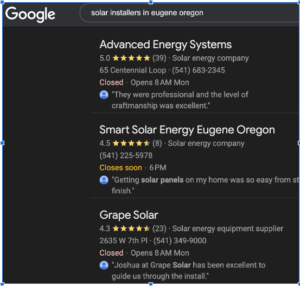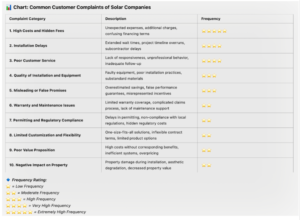Investing in a solar system is a significant decision that can lead to substantial savings and increased property value. However, navigating the myriad options available can be daunting, especially when obtaining a reliable solar Quote. For residents in Oregon considering solar power, understanding the importance of comparing multiple quotes is crucial. “Why does comparing multiple solar quotes save you money?” is a question many potential solar customers ask. It deserves a detailed exploration to ensure you make an informed and financially sound choice.
Why Comparing Multiple Solar Quotes Saves You Money
Comparing multiple quotes can lead to significant savings for several reasons:
1. Cost Comparison:
Solar panel and installation costs vary widely between companies. By comparing multiple quotes, you can identify the most cost-effective option, ensuring you are not overpaying for the same quality of service or equipment. This is vital because even slight differences in cost per watt can translate into substantial savings over the lifetime of the **solar system¹. We recommend comparing at least three solar quotes based on your community’s highest number of customers (solarreviews.com, Google Reviews, EnergySage.com).
2. Quality and Service:
Comparing quotes allows you to assess not only the price but also the quality of the solar panels and the professionalism of the service offered by different companies. This comparison can help you avoid companies that may use high-pressure sales tactics or offer subpar equipment at inflated prices². Additionally, considering premium options like Tesla Solar Panels and the innovative Tesla Solar Roof can ensure higher efficiency and aesthetic appeal, adding value to your solar system project. When looking at reviews of any service company, you want to look for trending issues.
Data Source and Methodology
The data presented in this chart was gathered by analyzing customer reviews from significant platforms such as Google Reviews, Better Business Bureau (BBB), Yelp, and Trustpilot. Additionally, insights from research analysts and solar expert Kayl Enders of Advanced Energy Systems in 2024 were incorporated to identify and compare the top negative trending issues solar installers face. This comprehensive approach ensures a well-rounded understanding of the prevalent challenges within the solar installation industry.
3. Incentive Maximization:
Each installer may have different access to or knowledge of available solar incentives like rebates, which can significantly reduce your upfront costs. Through comparison, you can choose a company that offers the best deal by leveraging these incentives³.
4. Tailored Solutions:
Different companies might propose different system sizes or types of equipment based on your specific needs, roof layout, and energy consumption habits. Comparing multiple proposals ensures that you get a system tailored to your needs, maximizing efficiency and cost-effectiveness⁴. For homeowners aiming for seamless integration of solar power installation with their living spaces, consider solutions like a Tesla house, which incorporates Tesla Powerwalls and Solar Roofs that can provide a fully sustainable and energy-efficient home
5. Market Insight:
Gathering and comparing quotes can also provide you with greater insight into the solar power market, helping you understand what is a fair price and what constitutes good quality service within your region⁵.
The consensus among industry experts is that obtaining and comparing multiple quotes is not just about finding the lowest price but finding the best value proposition that balances cost, quality, service, and incentives¹. This matters because it ensures you are making a well-rounded decision that will benefit you financially and in terms of energy efficiency for years to come.
Comparing quotes not only helps you save money but also avoids potential pitfalls that could lead to long-term issues. Learn more about What Can Go Wrong with Your Home Solar? Common Home Solar Problems to Avoid.
But how do you effectively compare these aspects to make the best choice? Let’s delve into the practical steps.
How to Compare Solar Panel System Costs
When comparing solar panel prices for your home, it’s essential to consider both the hardware and soft costs associated with the installation. The U.S. Department of Energy emphasizes that the cost of solar panels has been consistently decreasing, which includes both the panels themselves and related installation costs like permitting and inspection³.
Steps to Obtain Multiple Quotes and Make the Right Choice
1. Do your Research
A. Ensuring Competitive Pricing
Solar installation costs vary widely between providers, sometimes by as much as 30%. You can compare prices and ensure you’re getting a fair deal by contacting several reputable installers. For instance, if one installer quotes $18,000 for a 6 kW system and another quotes $19,000 for the same setup, you can evaluate which offer provides better value based on additional factors like warranties or system efficiency.
B. Assessing Quality and Value
The cheapest quote isn’t always the best option. Different installers may use varying quality materials, offer different warranty periods, or provide distinct service levels. Comparing multiple quotes allows you to assess these factors comprehensively. For example, Installer A might offer a slightly higher price but include a 25-year panel warranty, whereas Installer B offers a lower price with a 20-year warranty. Understanding these differences helps you choose to balance costs with long-term benefits.
C. Staying Informed About Market Trends and Incentives
Solar technology and incentives are continually evolving. Multiple quotes can provide insights into the latest trends, available incentives, and how providers incorporate them. For instance, one installer might include the latest high-efficiency panels or offer assistance in maximizing your eligibility for state and federal incentives.

2. Identify Reputable Installers
Start by identifying certified and reputable solar installers in your area. Utilize trusted resources like the Solar Energy Industries Association (SEIA) to find certified companies. For example, if you live in Eugene, Oregon, use the SEIA directory to shortlist five companies with high ratings and necessary certifications.
Verifying credentials like NABCEP (North American Board of Certified Energy Practitioners) ensures quality and professionalism.
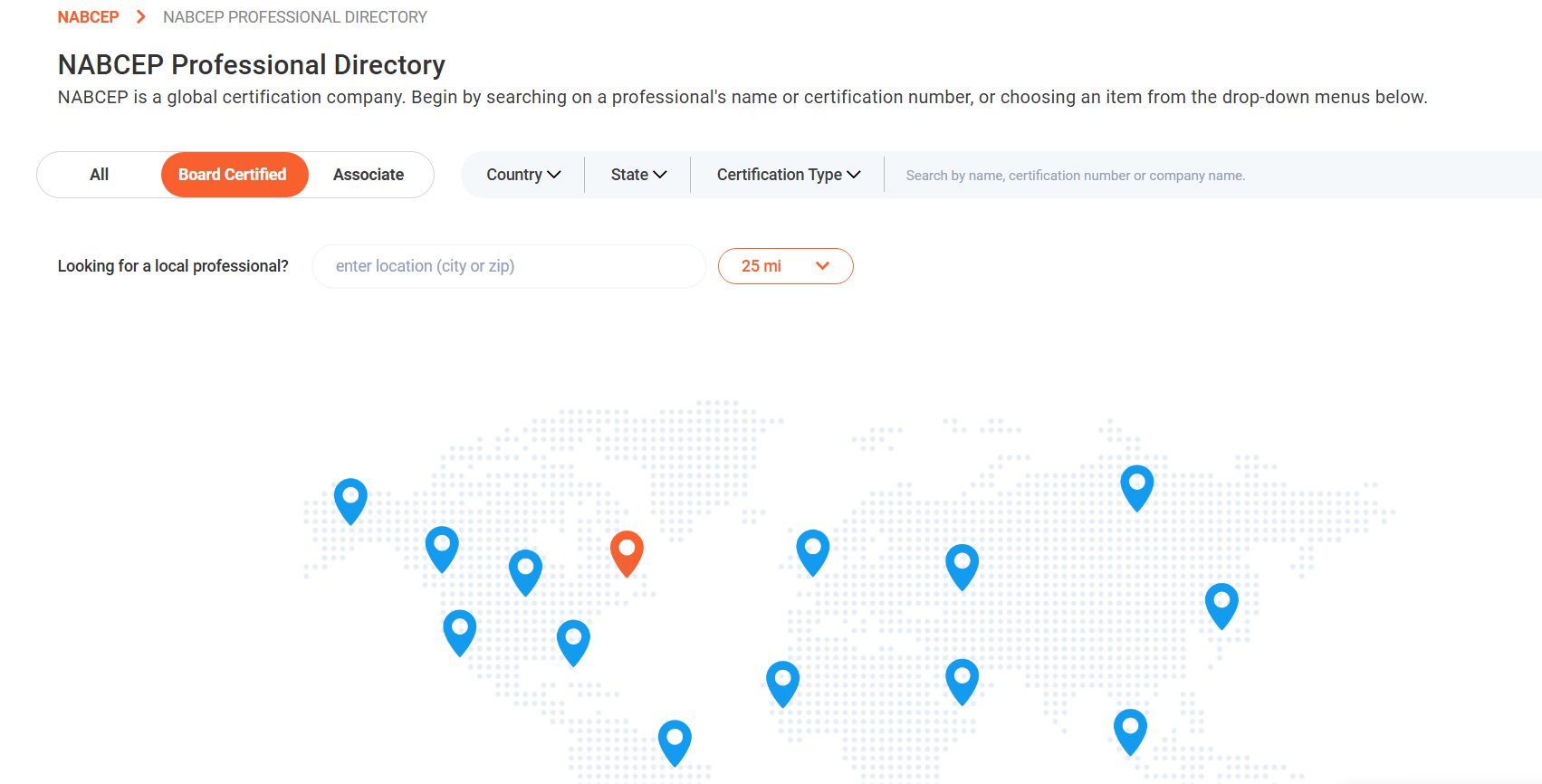
3. Gather and Prepare Essential Information
Before requesting quotes, prepare detailed information about your property. This includes your average monthly energy consumption, roof type (e.g., asphalt shingles), roof age, shading issues from trees or buildings, and existing electrical setups.
Example:
Create a spreadsheet listing your last 12 months of electricity bills to show an average consumption of 900 kWh per month. Note that your roof is an asphalt shingle roof installed 10 years ago, and mention a few trees that cast shadows in the mornings.

4. Request Detailed Proposals
When contacting installers, clearly communicate your energy goals and preferences. Ensure each quote includes similar system sizes, panel types, inverter quality, and expected energy output for an accurate comparison.
Example:
Tell installers, “I aim to reduce my monthly electricity bill by 70% and prefer using _____ panels for their high efficiency.” Review each proposal to confirm that all include a ______ kW system with _________monocrystalline panels and _______ inverters, producing approximately ________kWh annually.

5. Evaluate Financial Options and Incentives
Understanding your financial options is crucial. Compare the costs and savings of purchasing your solar system outright versus financing through loans. Additionally, maximize available rebates and incentives to reduce overall costs.
Example:
Calculate that purchasing the system outright costs $18,000, while financing through a solar loan at 5% interest over 10 years totals $20,000. Estimate that loan payments ($212/month) are lower than your current energy bill ($250/month). Take advantage of the Federal Investment Tax Credit (ITC) to deduct 30% of your installation costs, reducing your tax liability by $5,400.
While comparing quotes, consider how financing options can affect your decision. Explore more in our guide: Solar Financing for Homeowners: Sungage.
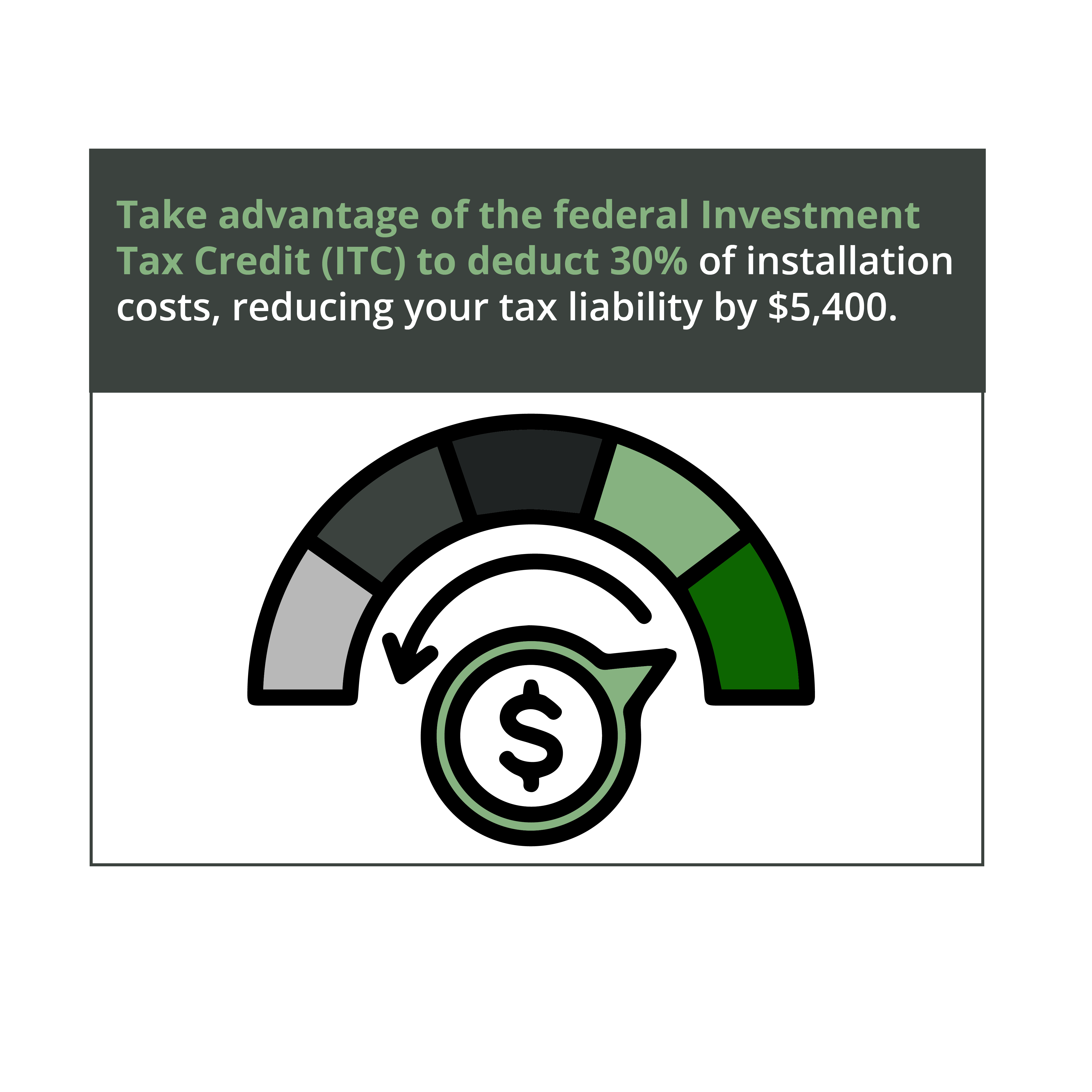
6. Assess System Costs and Installation Specifics
Ensure each quote provides a detailed breakdown of costs, including equipment, labor, permits, and any additional fees. Consider how roof type and installation complexity might affect costs and system performance.
Example:
Installer A provides a breakdown: $12,000 for panels and inverters, $4,000 for labor, $1,000 for permits, and $1,000 for miscellaneous fees. Installer B lists $11,500 for equipment, $4,500 for labor, $1,200 for permits, and $800 for additional costs. If your roof is flat, ensure quotes include specialized mounting systems, which might add $500 to the total cost.
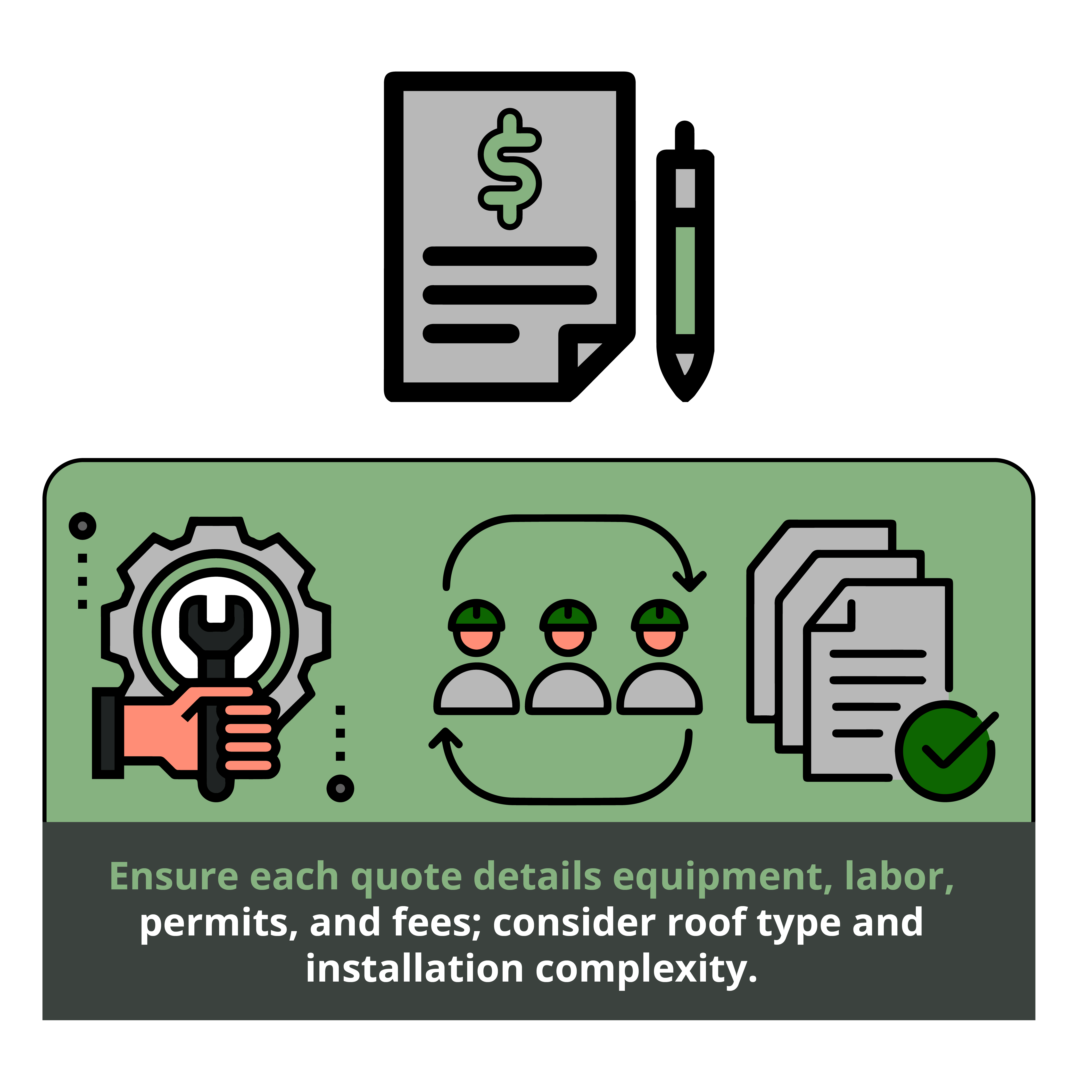
7. Understand the Levelized Cost of Electricity (LCOE)
LCOE represents the per-unit cost of electricity generated over the system’s lifetime, considering both direct and indirect costs. Calculating LCOE helps you understand the actual cost per kilowatt-hour (kWh) and the long-term value of each option.
Example:
Installer A’s $18,000 system, with a 25-year lifespan and a production of 7,500 kWh annually, produces 187,500 kWh of total energy. The LCOE is $18,000 / 187,500 kWh = $0.096 per kWh. Installer B’s $19,000 system delivers the same power, and the LCOE is $19,000 / 187,500 kWh = $0.101 per kWh. Installer A offers a slightly lower LCOE, indicating better long-term value.

8. Review Installer Credentials and Customer Feedback
Verify each installer’s certifications and read customer reviews to gauge satisfaction and reliability. It is also essential to compare warranty terms for solar panels and inverters.
Example:
Installer B has a 4.8-star rating on Google and numerous positive reviews. Contact a reference provided by Installer B, who shares their positive experience regarding timely installation and excellent customer service. Compare warranty terms: Installer A offers a 25-year panel warranty and a 10-year inverter warranty, while Installer B offers a 20-year panel warranty and a 10-year inverter warranty. Installer A’s more extended panel warranty may provide more peace of mind.

9. Create a Comprehensive Comparison Chart
Develop a comparison chart that includes all critical elements from each quote—cost, system size, efficiency, warranties, financing options, and installer reputation. This visual aid helps identify which option offers the best overall value.
Example:
Create a table with columns for Installer Name, Total Cost, System Size, Panel Type, Inverter Type, Warranty Terms, Financing Options, LCOE, Customer Ratings, and Additional Services. Populate the table with data from Installers A and B to compare their offerings easily.

Making an Informed Decision
After gathering multiple quotes and thoroughly evaluating each aspect, you’ll be well-equipped to decide which fits your needs best. Remember, the goal is to create an apples-to-apples comparison so you can see apparent differences. Suppose the information provided by one installer doesn’t match the information provided by another. In that case, it might mean the installer is trying to cloud your decision-making intentionally, and you should rule them out. When you compare apples-to-apples installers, you can make more informed decisions. For instance, you might find that Installer A offers slightly higher upfront costs but a lower LCOE, more extended warranties, and better financing options than Installer B. Additionally, Installer A has excellent customer reviews and is NABCEP certified, making them the superior choice for your solar installation needs.
Future Considerations:
If you plan to add an electric vehicle (EV) charger in the future, ensure the current system can accommodate the additional load. Note that Installer A’s system has scalable capacity, allowing easy future expansion, while Installer B’s system is limited.
Expert Advice:
Based on the solar energy advisor’s recommendation and your comparison chart, you decide to proceed with Installer A, confident that it offers the best cost, quality, and long-term benefits.
Additional Resources
- U.S. Department of Energy’s Homeowner’s Guide to Going Solar:
For a comprehensive understanding of the solar installation process, financing options, and maintenance tips, visit the Homeowner’s Guide to Going Solar.
- Solar Calculator Tools:
Utilize online solar calculators to estimate your potential savings and return on investment. Tools like the EnergySage Solar Calculator provide personalized estimates based on your circumstances.
But what flexibility do you have once you’ve gathered those quotes? Let’s explore the negotiability of solar quotes.
Are Solar Quotes Negotiable?
The good news is that solar quotes are generally negotiable. Members of the Solar Panel Talk forum often discuss their experiences with negotiating solar quotes, emphasizing the flexibility in pricing, especially when multiple quotes are compared ⁴ ⁵. It’s common for consumers to share tactics such as asking for price adjustments based on competitor quotes or adjusting system size and components to fit their budget better. Users also suggest that being well-informed about the system and its components can leverage negotiations effectively ⁴ ⁵.
For example, a user on Solar Panel Talk explained that after receiving multiple quotes, they could negotiate the price down by discussing the quotes with different installers and asking for adjustments based on the best offers they had received from others ⁴ ⁵. Another user noted that everything from the choice of panels to the specific payment terms could be subjects for negotiation, emphasizing that vendors are usually willing to adjust their prices to close the deal ⁴ ⁵
Suppose you want to learn more about effectively negotiating solar quotes. In that case, you might visit Solar Panel Talk and similar forums to see discussions and advice from other solar energy consumers. Effective negotiation can lead to significant cost savings and better terms, ensuring that your investment in solar power is as beneficial as possible.
With the ability to negotiate, how do you systematically compare these quotes to make an informed choice?
.

How to Compare Solar Quotes?

“How to Compare Solar Quotes?” is a fundamental question that addresses the methodology behind evaluating different solar Quotes. When comparing solar quotes, it’s crucial to look at several key factors that can significantly influence your decision-making process:
System Components: It is essential to understand the quality, efficiency, and warranty of the solar panels, inverters, and batteries being offered. EnergySage has released a Buyer’s Guide that allows consumers to compare these components across different brands on factors such as performance, quality, and cost¹⁶. Additionally, considering advanced options like Tesla Solar Panels and the Tesla Solar Roof can provide enhanced efficiency and aesthetic benefits.
Total Costs and Savings: Consider the upfront costs and the potential savings. As of 2024, the average price of a residential solar system in Oregon ranges from $2.50 to $3.50 per watt, translating to an upfront cost of approximately $15,000 to $21,000 for a typical 6 kW system before incentives⁷ .
Homeowners can expect to save between $800 and $1,200 per year on their electric bills with an adequately sized solar system for home¹⁸. With these savings, the payback period is typically around 9 to 14 years, depending on system size and incentives¹⁹, leading to a substantial return on investment over the system’s 25-year lifespan. Additionally, while Oregon’s specific Residential Energy Tax Credit ended in 2017, homeowners can still benefit from federal and state incentives, such as the Federal Residential Clean Energy Credit, which covers 30% of the installation costs, and the Oregon Solar + Storage Rebate Program, which provides up to $5,000 for solar systems¹⁹.
Installation and Operational Considerations: Evaluate the installer’s credentials, service history, and the proposed timeline for installation. The installer must provide a clear and detailed breakdown of all the operational aspects, including potential annual maintenance²⁰
Innovative Technologies: For instance, tools like Instant iQuote from Sungevity use sophisticated technology to provide immediate and personalized solar quotes by entering a street address. This tool uses LIDAR and aerial imagery to accurately assess your home’s solar potential and can give you a quick estimate of costs and savings²¹.
Considering these aspects, you can make a well-informed decision on which solar proposal offers the best value for your needs. Always verify these details through credible sources and tools provided by the industry to avoid any discrepancies in the future. For a comprehensive comparison, you might visit Energy Sage guide or similar platforms that provide detailed comparisons and reviews¹⁶. This matters because a thorough comparison ensures you select a solar system project that aligns perfectly with your energy requirements and financial goals.
Understanding the components and costs is crucial, but how do you choose the right provider among the best? Let’s investigate.
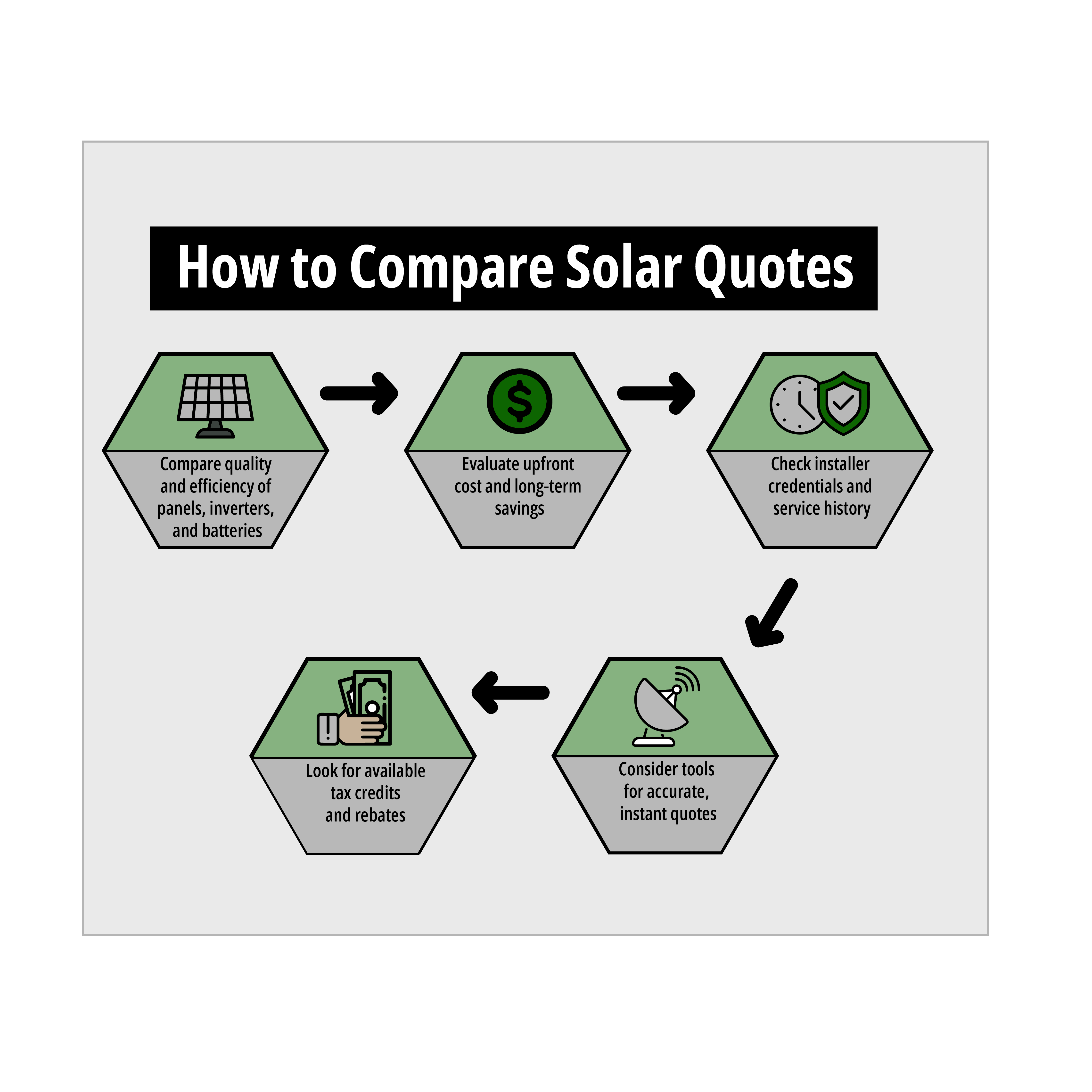
What Should I Consider When Choosing a Solar Provider?
When it comes to choosing a solar provider, comparing multiple quotes is a critical step to ensure you make an informed decision. Here are essential considerations based on insights from the YouTube video “How to Choose SOLAR Wisely and Avoid Costly Mistakes”:
-
Get Multiple Quotes: Obtaining several quotes allows you to compare costs and negotiate better terms. This approach helps you secure the best value, as comparing multiple offers ensures you’re not overpaying.
-
Technical Knowledge: A knowledgeable provider should be able to answer your questions confidently and guide you in choosing the best system type and size for your specific needs. This expertise is crucial for comparing different systems effectively.
-
Accreditation: Check if the provider has industry-standard certifications, like MCS or HEIS. Accredited providers are more likely to meet high standards in installation quality and service.
-
Warranties: Look for companies that offer long-term warranties—typically around 25 years for solar panels. By comparing warranties in each quote, you can better assess the protection and longevity of your investment.
-
Local Knowledge: Providers with local expertise understand specific regulations and permitting requirements. This knowledge ensures a smoother installation, particularly if your property has unique requirements.
These considerations underscore the importance of comparing multiple quotes as a way to find the best combination of quality, cost, and reliability. Choosing the right provider not only leads to a more efficient solar installation but also maximizes the long-term value of your investment in solar energy.
How Many Solar Quotes Should I Get?
“How many solar quotes should I get?” is a practical question that addresses the optimal number of solar Quotes to obtain for a comprehensive comparison. According to SolarReviews, it is recommended not to hesitate to gather multiple quotes from different providers¹. Comparing various proposals allows you to scrutinize different aspects like system size, costs, savings, financing options, and warranty terms to find the best fit for your needs and budget¹.
Gathering and comparing different quotes is crucial in understanding all your options and making an informed decision when choosing a solar system¹. Typically, obtaining three to five quotes is sufficient to get a broad market perspective without becoming overwhelmed. This number allows you to see a range of pricing and service offerings, giving you the leverage to negotiate better terms and prices¹.
This matters because the more solar Quotes you have, the better you can evaluate the market and ensure you’re receiving a fair deal.
It also provides a safety net against potential scams or overpriced services, ensuring that your investment in solar panels for your home is secure and beneficial in the long run¹.
Multiple quotes clarify, but what other advanced technologies can enhance your solar installation?
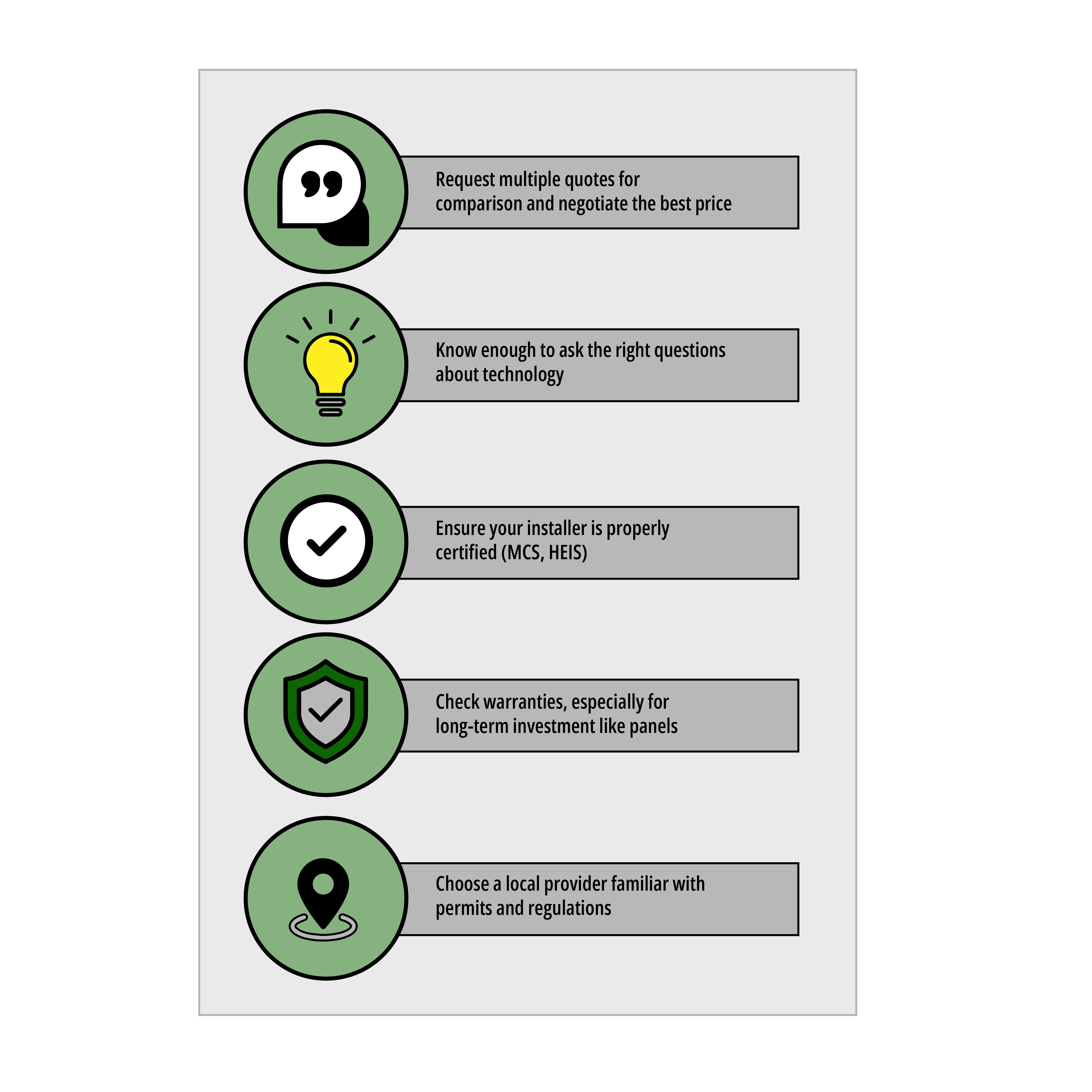
Additional Considerations
Throughout this article, we’ve explored the importance of obtaining multiple solar Quotes and the various factors to consider when deciding. Key takeaways include:
1. Cost Comparison: Always compare the costs of different solar companies to ensure you’re getting the best deal without compromising on quality.
2. Quality and Service: To avoid subpar installations, assess the quality of solar panels and the professionalism of the service.
3. Incentive Maximization: Leverage available incentives by choosing a provider to help you maximize rebates and other financial benefits.
4. Tailored Solutions: Ensure the solar system project is customized to your needs for maximum efficiency and cost-effectiveness.
5. Negotiability: Remember that solar Quotes are often negotiable, and being informed can help you secure better terms.
6. Comprehensive Comparison: Use detailed guides and tools to compare quotes thoroughly, considering all aspects, from system components to long-term savings.
7. Advanced Technologies: Consider integrating advanced solutions like Tesla Solar Roofs and Tesla Powerwalls for enhanced energy efficiency and aesthetic appeal.
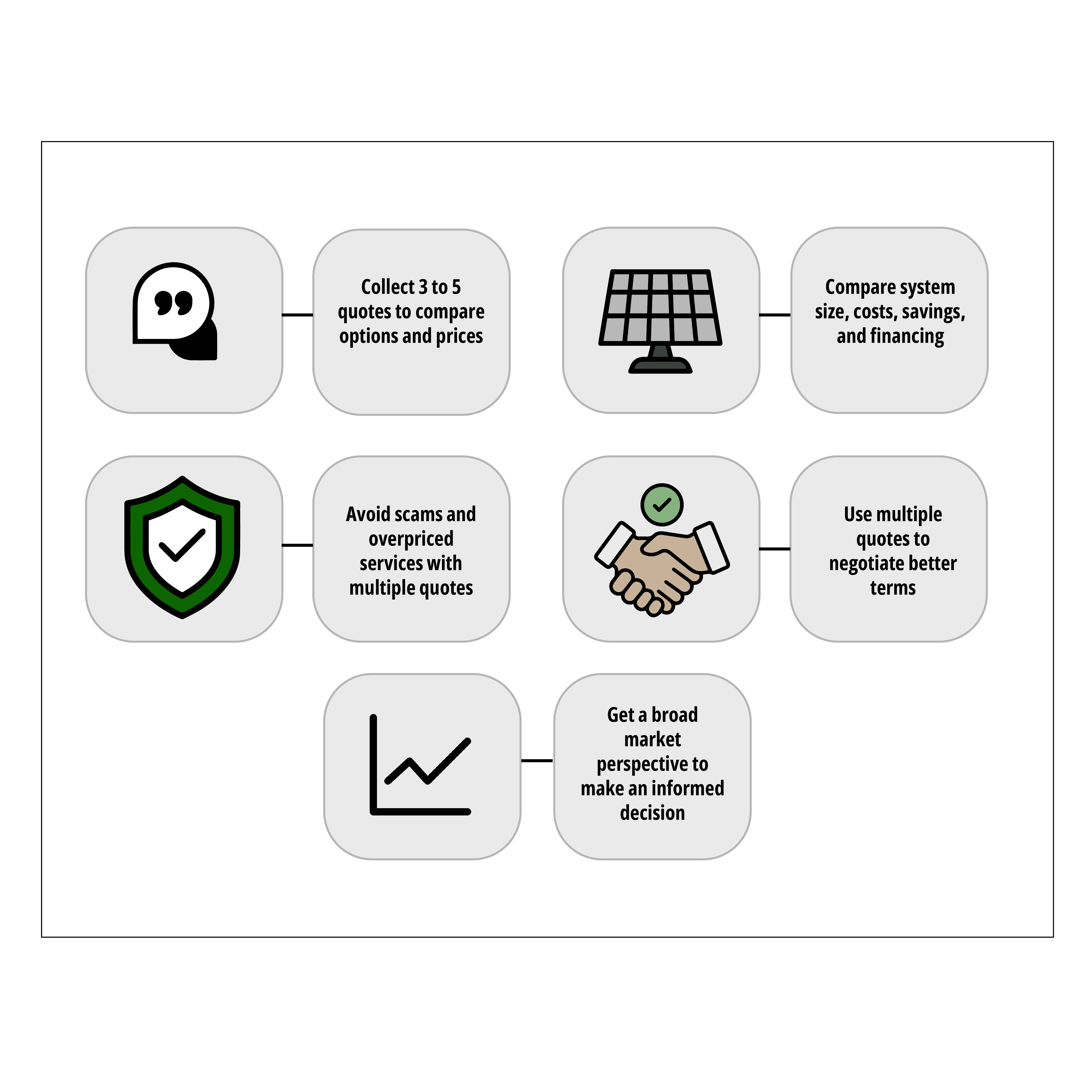
Additionally, addressing frequently asked questions can further enhance your understanding and decision-making process:
What are the benefits of choosing high-efficiency solar panels?
Opting for high-efficiency solar panels ensures maximum energy production even in limited space, making them ideal for homes with smaller roofs or higher energy demands. High-efficiency panels like Tesla Solar Panels can generate more power per square foot, reducing the number of panels needed and minimizing the impact on your roof’s appearance.
How does the size of my roof affect the number of solar panels I need?
Assessing your roof size is crucial in determining the number of solar panels required for optimal energy generation. A professional assessment will help tailor a solar system project that fits your roof layout and energy needs. For instance, a more extensive roof can accommodate more solar panels for your home, allowing for more excellent energy production and potential cost savings.
What maintenance is required for a solar power system?
Regular maintenance of your home’s solar power system ensures longevity and efficiency. Most solar energy companies offer maintenance packages that include routine inspections and cleaning of solar panels to keep your system running smoothly. Additionally, integrating energy storage solutions like the Tesla Powerwall can reduce wear and tear on your system by optimizing energy usage patterns.
As a Local Solar Expert at AES Installer Company, I’ve seen firsthand how obtaining and comparing multiple solar Quotes can lead to better financial outcomes and more satisfying installations. Making an informed decision saves you money and ensures your home’s solar power is optimized for your specific energy needs.

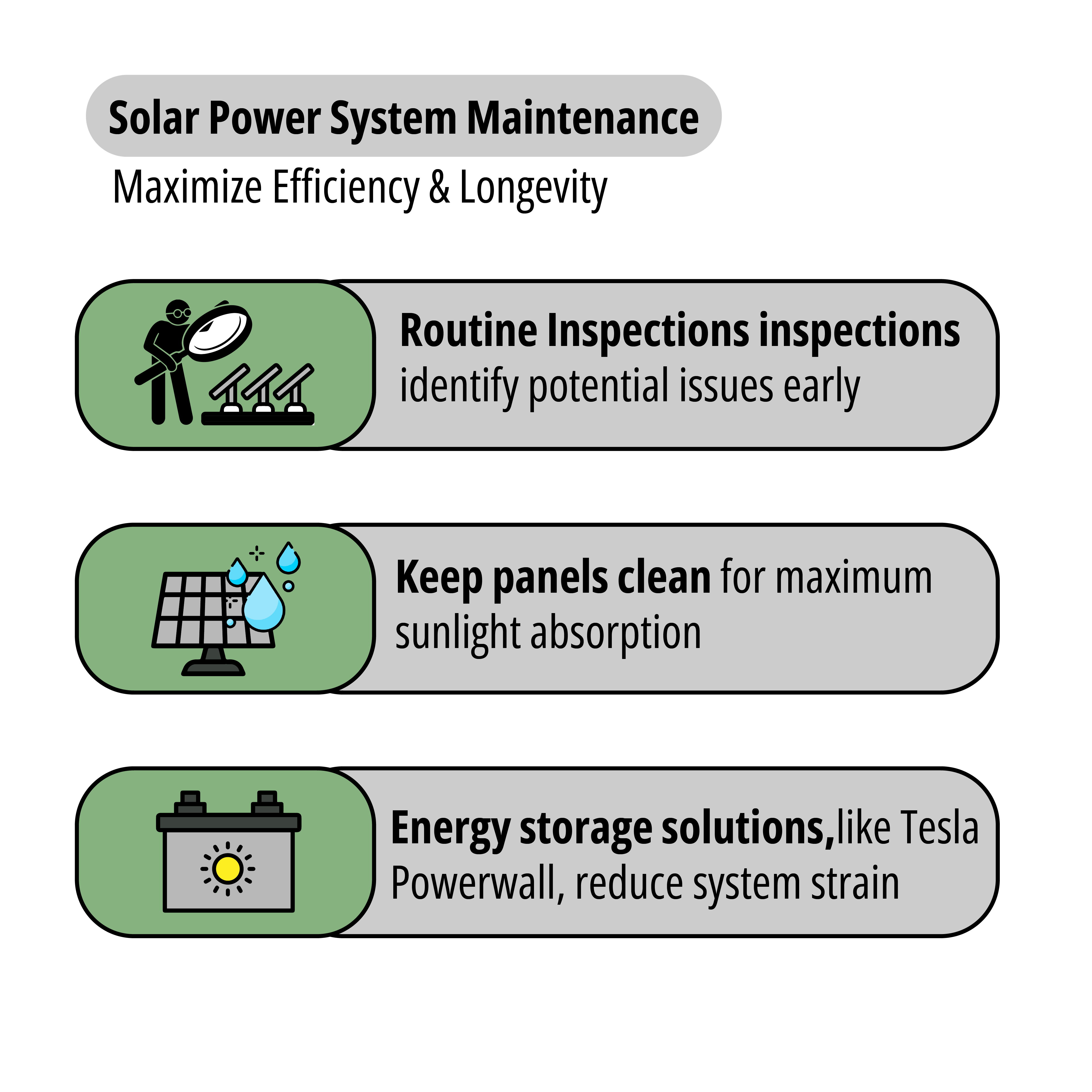
REFERENCES.
¹ SolarReviews – How to Compare Solar Quotes. https://www.solarreviews.com/blog/how-to-compare-solar-quotes
² SolarReviews – Avoiding Solar Panel Scams. https://www.solarreviews.com/blog/solar-panel-scams
³ Energy.gov – Homeowner’s Guide to Going Solar. https://www.energy.gov/eere/solar/homeowners-guide-going-solar
⁴ Solar Panel Talk – Negotiating Solar Quotes. https://www.solarpaneltalk.com/forum/solar/how-much-do-solar-panels-cost/383618-solar-panel-choices-sunpower-e20-vs-solaria-powerxt-vs-hanwha-qcell
⁵ Solar Panel Talk – Comparing and Negotiating Quotes. https://www.solarpaneltalk.com/forum/solar-panels-for-home/solar-panels-for-your-home/11135-comparing-two-quotes-and-negotiating
⁷ AESRenew. (2024). How much are solar panels for home in 2024? Recuperado de https://aesrenew.com/how-much-are-solar-panels-from-home-in-2024/
¹³YouTube. (n.d.). How to choose a solar system installer. YouTube. Recuperado de https://www.youtube.com/watch?v=1xFAiMI3qsc
¹⁶ Solar Power World – Comparing Solar Quotes. https://www.solarpowerworldonline.com/2019/07/energysage-releases-buyers-guide-that-compares-panel-inverter-and-battery-models/
¹⁸ EnergySage. (2024). Oregon solar panel installations: Data on costs and incentives. Recuperado de https://www.energysage.com/local-data/solar/or/
¹⁹ EnergySage. (2024). Oregon Solar Incentives, Tax Credits & Rebates 2024. Recuperado de https://www.energysage.com/local-data/solar-rebates-incentives/or/
²⁰ Solar Power World – Installation and Maintenance Considerations. https://www.solarpowerworldonline.com/2020/03/how-adding-shading-analysis-to-your-quotes-can-boost-your-sales/
²¹ Solar Power World – Innovative Solar Technologies. https://www.solarpowerworldonline.com/2021/04/solarreviews-analyzed-400k-solar-quotes-to-find-residential-adoption-trends-from-last-five-years/


